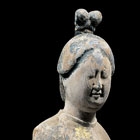J.J. Lally & Co., Oriental Art / New York City, New York
MenuPast Exhibition
Ancient Chinese Tomb Sculpture
March 22 - April 10, 2004
19.
A PAINTED AND GILDED WOOD FIGURE OF A COURT ATTENDANT
Tang Dynasty, A.D. 7th Century
shown standing in a respectful pose with left hand held in front and close to the body, the right arm broken off at the elbow, wearing a long, belted tunic with plain front and low collar, showing extensive remains of gilding on the sleeves and down the front, and with gold borders on either side of the slash-cut vents below the knees which open to reveal bright green trousers and the edges of a red-painted under-robe, the face with small, feminine features and red-painted lips, the hair pulled up into a small topknot and painted black, the wood dry and deteriorated in back, showing attractively patterned natural grain on the front.
Height 17 7⁄8 inches (45.4 cm)
Several fragments of painted wood tomb figures including the heads of male and female figures in court dress, the head of a Central Asian, the legs of horses, and the head and torso of a lokapala, all discovered in 1985 in Tang dynasty tombs at Yanchi in Ningxia province, northwestern China, are illustrated in an excavation report in Wenwu, 1988, No. 9, pp. 43-56.
A pair of wood figures of female attendants in the William Rockhill Nelson Gallery of Art – Atkins Museum of Fine Arts, Kansas City, exhibited at the Portland Art Museum in 1976, are illustrated by Donald Jenkins in the catalogue entitled Masterworks in Wood: China and Japan, Portland Art Museum, 1976, pp. 28-29, no. 8, dated to the Sui dynasty, circa A.D. 600.
A simple carved wood figure of a courtesan of the so-called ‘fat lady’ type, with traces of painted decoration in black and colors, excavated from a Tang site in Qinghai is illustrated in A Selection of the Treasure of Archeological Finds of the People’s Republic of China 1976-1984, Beijing, 1987, no. 376.
Compare also the three Tang dynasty painted wood figures shown in the Kaohsiung Museum of Fine Arts and illustrated in the catalogue entitled Ancient Chinese Sculptural Treasures: Carvings in Wood, Kaohsiung, Taiwan, 1998, cat. nos. 38-40.
